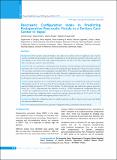Please use this identifier to cite or link to this item:
https://hdl.handle.net/20.500.14356/1242| Title: | Pancreatic Configuration Index in Predicting Postoperative Pancreatic Fistula in a Tertiary Care Center in Nepal |
| Authors: | Shah, Surendra Ghimire, Bikal Paudel, Sharma Singh, Yogendra Prasad |
| Citation: | ShahS., GhimireB., PaudelS., & SinghY. P. (2020). Pancreatic Configuration Index in Predicting Postoperative Pancreatic Fistula in a Tertiary Care Center in Nepal . Journal of Nepal Health Research Council, 18(2), 172-177. https://doi.org/10.33314/jnhrc.v18i2.2395 |
| Issue Date: | 2020 |
| Publisher: | Nepal Health Research Council |
| Article Type: | Original Article |
| Keywords: | Pancreaticoduodenectomy pancreatic configuration index postoperative pancreatic fistula |
| Series/Report no.: | Apr-June, 2020;2395 |
| Abstract: | Abstract Background: Post-operative pancreatic fistula is the single most common and most significant cause of post-operative morbidity and perioperative mortality. Identification of at risk patient preoperatively help to take policy of extra vigilance to act on time. This study evaluated the predictive role and cut-off value of pancreatic configuration index to predict post-operative pancreatic fistula. Methods: This was a prospective observational study in patients who had undergone pancreaticoduodenectomy from March 2017 to June 2018 at Tribhuvan University Teaching Hospital, Kathmandu, Nepal. The patients with age <16 years, those who underwent re-exploration or mortality before 3rd postoperative day, additional surgery besides pancreaticoduodenectomy were excluded from the study. Pancreatic configuration index was calculated as a ratio of pancreatic parenchymal thickness and pancreatic duct diameter. Predictive value of pancreatic configuration index in predicting post-operative pancreatic fistula was evaluated. Results: Among 58 patients, 9 were excluded from study and 49 patients were included in the study. The mean age of the patients was 56.6 ± 13.9 years (21 to 79 years) and male to female ratio was 1.1:1 (26 vs 23). Post-operative pancreatic fistula developed in 13/49 (26.5%) patients. On both univariate and multivariate analysis, pancreatic texture (p = 0.022), main pancreatic duct diameter at neck (p = 0.002) and pancreatic configuration index (p = 0.001) were significantly associated with development of post-operative pancreatic fistula. The sensitivity and specificity of pancreatic configuration index to predict post-operative pancreatic fistula are 92.3% and 91.7% with positive predictive value of 80% and negative predictive value of 97.1%. Conclusions: Pancreatic configuration index is a useful preoperative predictor of post-operative pancreatic fistula after pancreaticoduodenectomy. Keywords: Pancreaticoduodenectomy; pancreatic configuration index; postoperative pancreatic fistula |
| Description: | Original Article |
| URI: | http://103.69.126.140:8080/handle/20.500.14356/1242 |
| ISSN: | Print ISSN: 1727-5482; Online ISSN: 1999-6217 |
| Appears in Collections: | Vol. 18 No. 2 Issue 47 Apr-Jun 2020 |
Files in This Item:
| File | Description | Size | Format | |
|---|---|---|---|---|
| 2395-Manuscript-17508-1-10-20200911.pdf | Fulltext Download | 458.65 kB | Adobe PDF |  View/Open |
Items in DSpace are protected by copyright, with all rights reserved, unless otherwise indicated.
